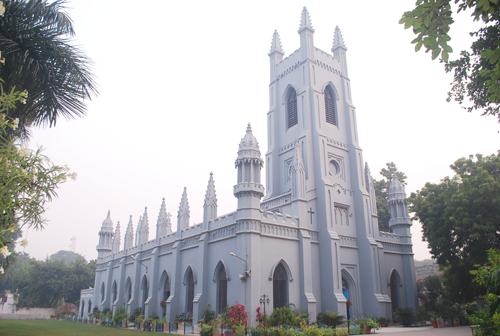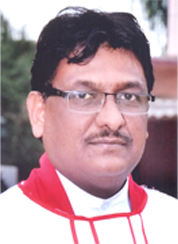
The story of Christ Church is intimately connected with the establishment of a cantonment in Kanpur, following the defeat of Shuja-Ud-Daulah, the Nawab Wazir of Oudh by the East India Company in 1865.
 In the early days of the British presence in Kanpur the spirited welfare of the troops was looked after by the Army Chaplain. Henry Martyn an Army Chaplain, showed great enthusiasm for preaching Christianity in the urban population in Kanpur and also to establish a permanent place of worship in the city. In June 1810 he was asked to persuade the military authorities to give him a thatched bungalow, about 80 ft. in length, situated near the Katcheri Hill adjacent to the erstwhile D.A.V. College Hostel. The new "Church", meant exclusively for Europeans was opened for divine worship and was to remain the only permanent place of Christian worship for the next thirty years, till Christ Church was built.
In the early days of the British presence in Kanpur the spirited welfare of the troops was looked after by the Army Chaplain. Henry Martyn an Army Chaplain, showed great enthusiasm for preaching Christianity in the urban population in Kanpur and also to establish a permanent place of worship in the city. In June 1810 he was asked to persuade the military authorities to give him a thatched bungalow, about 80 ft. in length, situated near the Katcheri Hill adjacent to the erstwhile D.A.V. College Hostel. The new "Church", meant exclusively for Europeans was opened for divine worship and was to remain the only permanent place of Christian worship for the next thirty years, till Christ Church was built.
John Webster in his book ‘ The Christian Community and Change in Nineteenth Centry
North India’ states ‘ the work of the American Presbyterian Church started in Kanpur
in 1901. The reason for choosing the place as a mission station was help the converts
get jobs in mills. The industrial development of Kanpur in the latter part of the
nineteenth century meant an opportunity of permanent employment for the Christian
community and a self supporting Church as a result.
The year 1827 marks a landmark in the history of Christ Church. It was in that year that a proposal to construct a 'pukka' church building was mooted by the European population of Kanpur and contributions were begun. Bishop Wilson the Lord Bishop of Calcutta Diocese was greatly interested in the expansion of Christianity in the North Country. Due to the Bishop's interest a sum of Rs. 27000/-could be collected through local contributions. An additional Rs. 2500/- was obtained through sale of material of an old building. Another Rs. 5000/- was given by the Diocese. Bishop Wilson in his whirlwind tour of the North in 1836, laid the foundation stone of Christ Church on 4th of February 1837, which was opened for Divine Service on 4th of January 1840. Zoe Yalland, a British historian in Kanpur in 1980's gave the cost of Christ Church at Rs.32402/- "intended to seat 800 people, and dominating the surrounding area with its 130 ft. Tower."
During the uprising of 1857, Christ Church was severely damaged as it served as a store-cum-cook house for the troops of Nana Sahib and later by the British themselves. Christ Church was handed over to the SPG in 1862, and was the Anglican Church of Civil Lines after Independence when it was handed over to the Indian Christian Community. The foundation stone of a Parsonage to the North of Christ Church building, with several servants' quarters was laid by Bishop S. A. Bill, the Lord Bishop of Lucknow Diocese on 12th September, 1940.
A brief history of the church union movement leading to the formation of the Church of North India, would not be out of place. The drive for union between all branches of Christianity started as early as 1910 in the Conference of World Missionary Council at Edinburough. The efforts of Bishop V.S. Ezariah, an Indian Bishop from Tinneveli in South India led to the foundation of the Church of South India (CSI) in 1947. The drive for a union in North India continued with the coming into existence of Pakistan in 1947. The branch of the Church of England in India began to be known as the Church of India, Pakistan, Burma & Ceylon (CIPBC). After many plans of negotiation, the agreement was reached and the Church of North India (CNI) was consecrated at the Nagpur Cathedral on 29th November, 1970. Six Churches which united to form the Church of North India were The Council of Baptist Churches in Northern India, the Church of the Brethren in India, the Disciples of Christ, the Church of India (formerly called the Church of India, Pakistan, Burma and Ceylon), the Methodist Church (British and Australasian Conferences) and the United Church of North India. Organised into 26 Dioceses, of these the Lucknow Diocese was split in 1976 into two Dioceses, the Lucknow Diocese and the Agra Diocese (established on 9th April, 1976). The former contained all the Parishes South of the Ganges and the latter all the Parishes North of the Ganges.
The Revd, S.P. Lal, the present Presbyter-in-Charge of Christ Church, Kanpur, joined in October 1995 and due to his dynamic leadership, he was able to gather funds from local members of the Church and loan from the Diocese of Agra, for repairs and beautification of the Church and its surroundings. The Sunday School building was constructed and toilets put up in 2003. All benches in the Church were repaired and polished and the complete flooring of the Church was replaced by marble stone. The surroundings of the Church building were also beautified and a lawn and flower beds were laid. The road leading to the Church and a gate near the All Soul's Parsonage were also constructed, by the generous help of our MLA. The repairs and renovation and the gardens surrounding it were completed by December 2010, and blessed by the serving Bishop of Agra Diocese, the Rt. Revd. S.R. Cutting on 30th January 2011. All the renovation work of the church building including the lawns around it were done by donations from local members and loan from the Diocese, which was promptly repaid.
In concluding this brief history of Christ Church which would be celebrating its 175th Anniversary of Consecration on January 4th, 2015, we pray that Christ Church would stand as a symbol of unity and love, of our Lord, for a thousand years. We thank God for all His servants that served in this Church and also thank Him for all the worshippers that had worshipped in the past, are worshipping today and will be worshipping in the future.
(History Compiled By : Dr. ABK Sebastian, Retd. Prof., Sociology, Christ Church Degree College, Kanpur)
Rev. S. P. Lal Presbyter-in-Charge